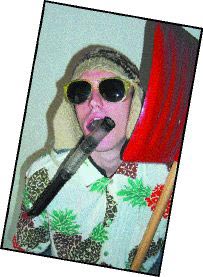IT SEEMS LIKE you can’t open a newspaper or turn on TV without encountering confident predictions about what the weather’s going to be like a hundred years from now. So what I want to know is: If you climatologists are so damn smart, why won’t you give us a tip about how the skiing’s going to be this winter?
Oh, I know: The forecasts for global warming and desertification and sea-level rise come from mathematical models of climate that have trouble enough predicting what the average annual rainfall in the whole Pacific Northwest is going to be, let alone the snowpack next January at Alpental. But can’t meteorologists at least give us odds on whether we’ve got a fighting chance of seeing powder before April, or whether we should leave the new K2 Totally Piste tele skis in storage and instead book the time-share at Cancn?
No dice: The most you can extract this year from heavy weatherheads—even those who ski themselves—runs something along these lines: “We would be very surprised if this winter is as dry as last winter. Last winter was one of the two driest in the last hundred years. There is no reason to expect that two winters that dry would happen back-to-back.
“Of course, weather depends on myriad factors, many of which we do not yet fully understand, so there is no guarantee that such a sequence of dry winters could not occur. Such a sequence in a record extending back a mere hundred years could easily occur through pure chance.”
Right.
THE MOST ANNOYING aspect of the situation for both snow buffs and meteorologists is that we do now know the two main influences upon Northwest climate, but neither is now sending a clear enough signal to tip the weather odds one way or the other.
The first factor that’s been understood longest is called ENSO, shorthand for El-Ni�outhern Oscillation. A large shallow layer of warm water occupies a patch of Pacific Ocean surface water about the size of South America.
Every four years on average, the steady westerly winds near the equator spread the patch toward the east coast of Peru, pulling the course of the Northern Hemisphere jet stream southward (and the storm tracks of the North Pacific along with it). Result: Water vapor that would have been dumped on the Cascades as precious hexagonal crystals instead falls on the Hollywood Hills as rain and washes movie stars’ houses into the sea. (Please, lord, let it be Tim Allen this year.)
The process is self-limiting, because when the Pacific warm patch gets stretched out that far, the winds that keep it in place weaken, and soon the warm-cool frontier starts retreating west again. But though the grand outline is obvious in the weather record, the fine detail is irregular as hell. Right now, we’re on the cusp, with the last traces of El Ni�one but no sign yet of a fast return to the opposite extreme of wet, snowy conditions for the Northwest. This winter is up for grabs, ENSO-wise.
The second cycle affecting Crystal Mountain’s profits is not as well-known as ENSO, nor is its pattern as clear. NPO, the North Pacific Oscillation, has a much longer period than ENSO, repeating over 30 years or so instead of four, but it’s pretty clear that it has major effects on ocean temperature and currents and, in consequence, average rainfall in the Northwest. After more than 25 years on the dry side of the NPO cycle, there are strong indications that a wave of wetter years is in store.
BUT AGAIN, the NPO cycle is only about halfway between its historic extremes, so most of the variation we can expect to see this winter lies in the lap of randomness: that portion of the weather signal that derives from causes we don’t yet, and may never, understand.
So, sorry, but science can’t offer much help in planning your winter vacation this year. With any luck, the next few winters will see us comfortably back in a series of wet-ENSO, wet-NPO years, and the floodlit slopes of Snoqualmie Pass will again offer solace to after-work snowboarders.
Enjoy those seasons when they come. If one thing emerges clearly from the crunched numbers of the climate modelers, it’s that snow is as endangered a Northwest species as the razor clam. ENSO and NPO determine how much precipitation the Northwest gets, but not how much of it sticks around Stevens Pass long enough to be schussed on.
Snow lines are already hundreds of feet higher than they were a century ago. Snowpacks last on average weeks less than they used to. Amortize those pricey new V�Carver V4s while you can. Before today’s baby-slopers are old enough for their first Sniagrab, there may be nothing for them to get outfitted for.








